A comprehensive macaron troubleshooting guide with photos, possible causes and how to avoid the most common macaron issues!
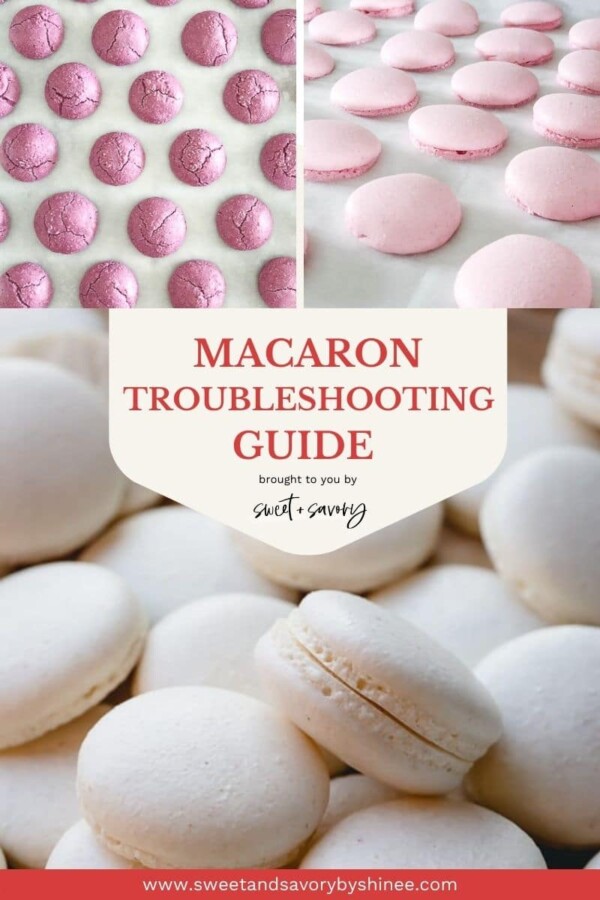
Table of Contents
Since 2012, I’ve made thousands of macarons in my home kitchen with many trials and errors, as well as picture-perfect macarons! And yes, I’ve had pretty much every problem imaginable!!
In the process, I’ve gained lots of tips and tricks to solve those frustrating issues and, most importantly, how to avoid them in the first place.
Remember, sometimes, macarons fail for no apparent reason and leave us scratching our heads.
But I encourage you to never give up on macarons. The joy of watching your macarons grow those ruffled feet and pulling out perfectly round macarons with shiny smooth tops is simply priceless.
I swear, every single time, when I see my macarons through the oven door puffing up and baking perfectly, I can’t help but do a little happy dance in my kitchen! Pure joy, I’m telling ya!
What’s a perfect macaron?
Perfect macaron is very subjective. To me, a perfect macaron has the following characteristics:
- Smooth shells
- Ruffles feet
- Full inside
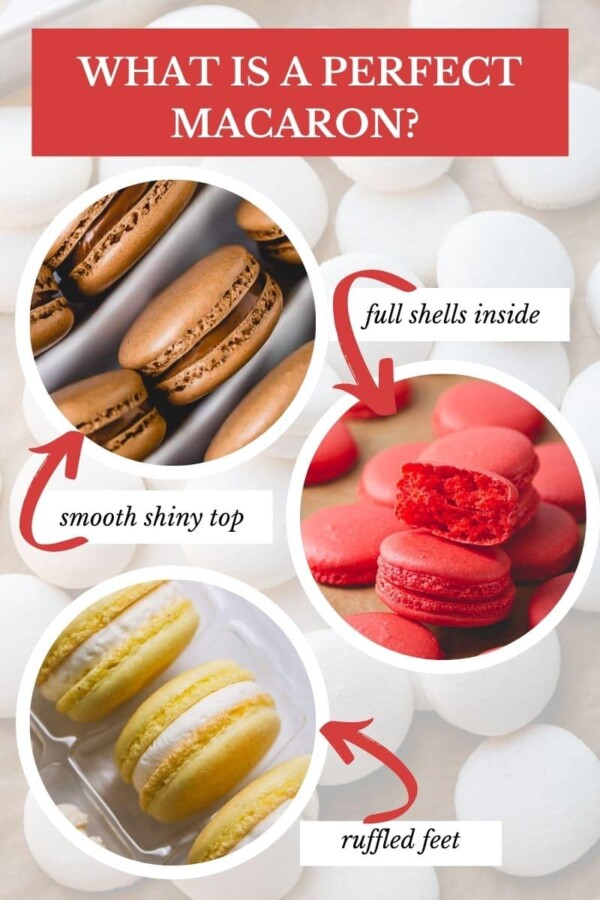
Macaron Troubleshooting Video
Visual Macaron Troubleshooting Guide
Ok, let’s discuss each of the most common macaron issues, their causes and how to fix or prevent them!
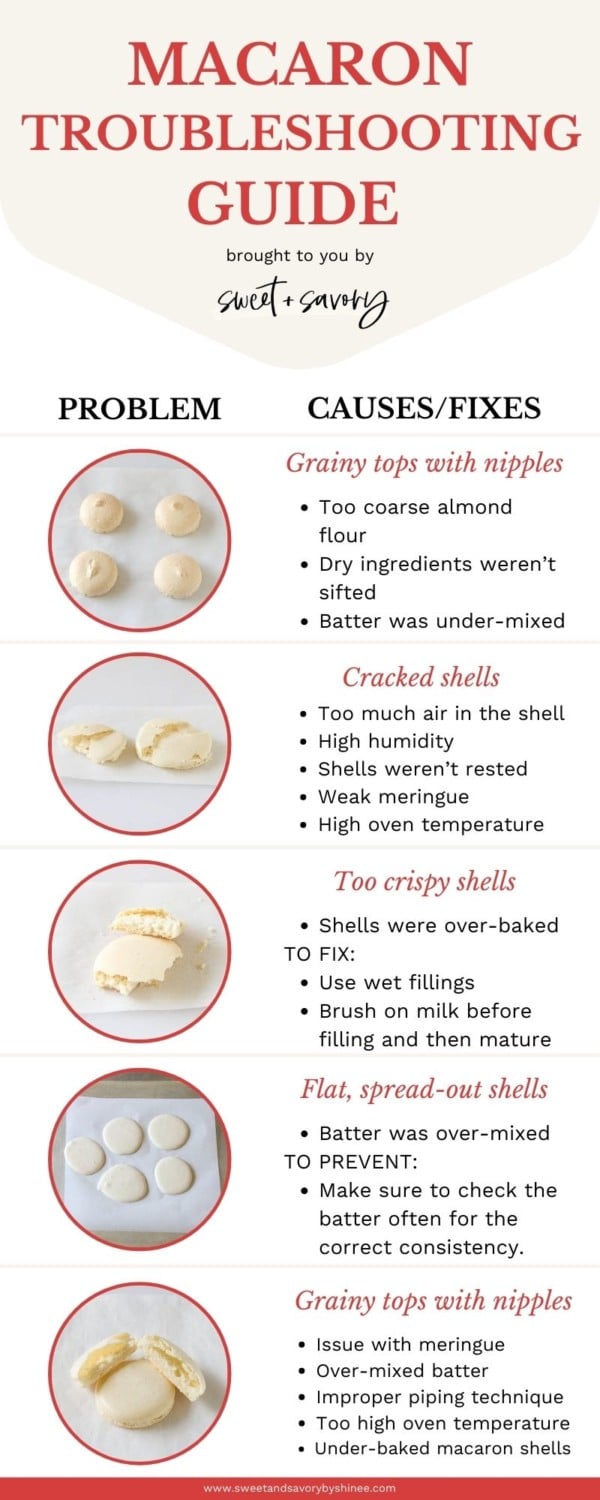
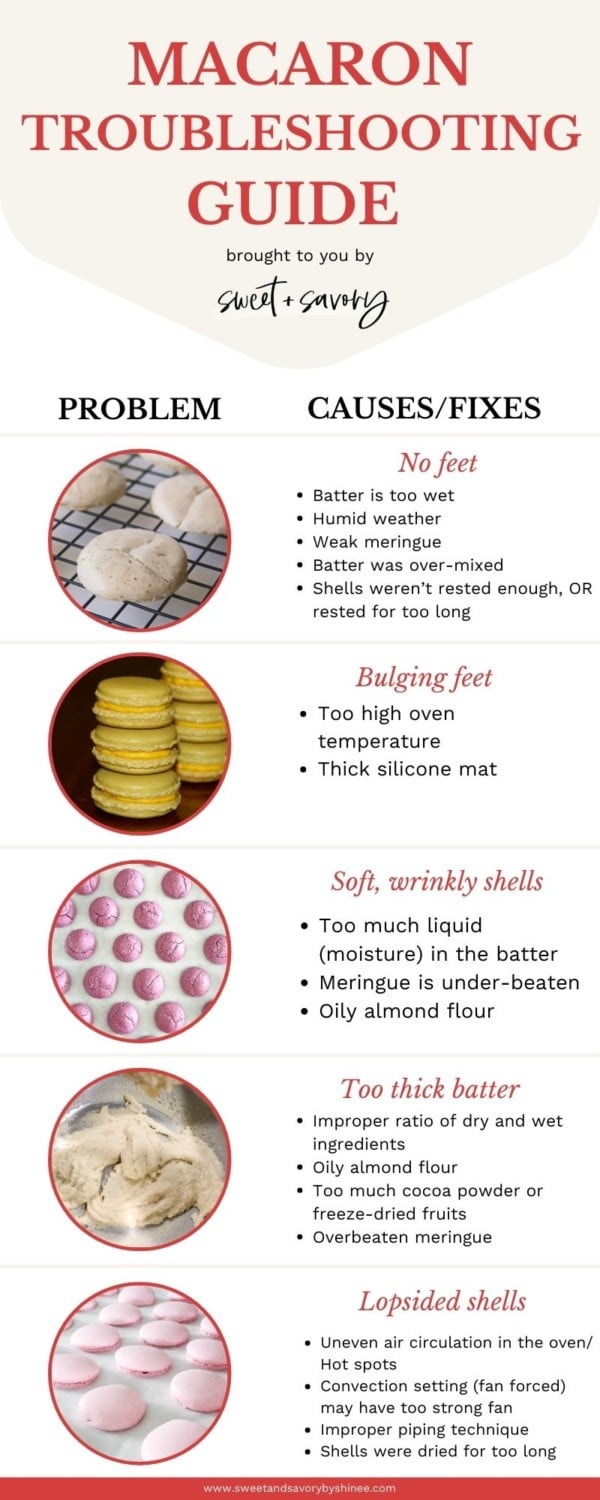
Pin this now to find it later
Pin ItUneven, grainy macarons with nipples
Possible causes:
- Too coarse almond flour
- Dry ingredients weren’t sifted
- Batter was under-mixed
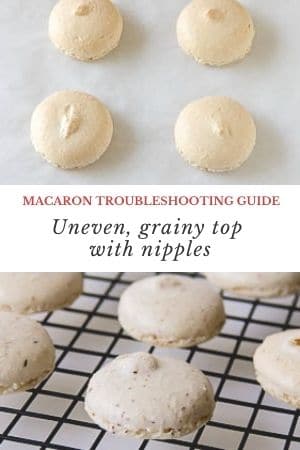
how to fix grainy shells with nipples:
- Make sure to use fine ground almond flour.
- Don’t skip sifting the dry ingredients! Toss large almond pieces left in the sifter. You shouldn’t have more than 1/2 tablespoon of almond bits.
- Under-mixed batter also causes grainy shells with nipples. When mixed right, the nipples should melt back into the batter after tapping the piped shells on the counter.
don’t do this!
Never use wet fingers to push the nipples down. Instead, use a toothpick to encourage the batter even out.
Cracked shells
Possible causes:
- Too much air in the shell
- High humidity
- Shells weren’t rested
- Weak meringue
- High oven temperature, or hot spots in the oven
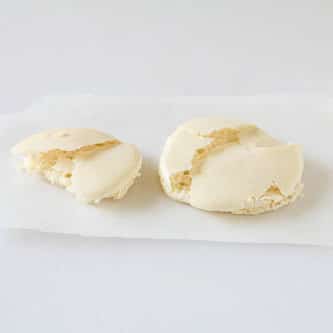
HOW TO FIX cracked macarons:
- Be sure to tap the baking sheet right after piping macaron shells. And use a toothpick to pop large air pockets visible on the surface.
- When it’s too humid, the shells don’t develop good skin, which leads to the next point.
- When the shells haven’t rested long enough to develop skin on top, steam releases from anywhere cause macarons to crack on top.
- Take your time to make nice and sturdy meringue, especially when you’re making French meringue. Watch my video on French Meringue 101 to learn all the tips to make the most stable French meringue.
- Too hot oven can also cause cracks in macaron shells. Make sure to get an oven thermometer to double check the temperature inside the oven without relying on what oven says.
Erupted shells
Possible cause:
- Touched the shells with wet finger to push down a pointy nipple
How to prevent erupted volcano macarons:
Never touch your unbaked macaron shells with wet fingers to push down pointy end. Instead tap the baking sheet well. And if the pointy end doesn’t melt into the batter, you can either baking them as is, or scrape the batter back into a bowl and mix for a little more until the batter is at correct consistency.
Too crispy interior
Possible cause:
- Shells were over-baked
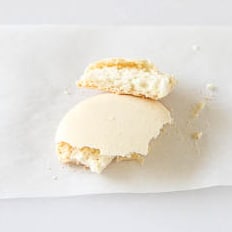
How to fix too crispy shells:
If you over-baked your macaron shells and now they’re super crispy throughout, don’t fret! 2 easy fixes:
- Use wet fillings, like jams, caramel sauce, or lemon curd in the center.
- Simply brush on milk on the bottom of the shells before piping a filling of choice.
Tip
Mature filled macarons for 24 hours. The shells will absorb the moisture from filling and macarons should soften nicely.
Flat shells, spread out too much
Possible cause:
- Batter was over-mixed
Over-mixed batter is too loose and the shells don’t hold its shape well, instead it spreads out too much.

How to prevent flat, spread out macarons:
Once macaron batter is over-mixed and it’s too runny, there’s no way to salvage it. So it’s important to prevent this from happening.
Make sure to check the batter often for the correct consistency. It should slowly run off the spatula into a ribbon, and the edges should melt back into the batter within about 10 seconds.
Hollow shells
Possible cause:
- Issue with meringue
- Over-mixed batter
- Improper piping technique
- Too high oven temperature
- Under-baked macaron shells
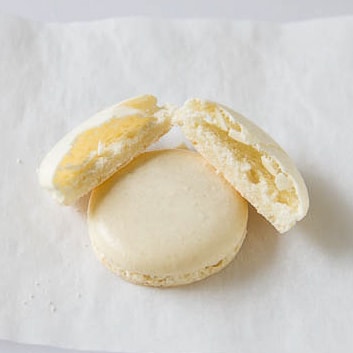
How to fix hollow macaron shells:
Hollow macarons are so common, and I personally battled with this issue for a long time. Now, I consistently get full, meaty macarons straight from the oven.
Since it’s a complex issue, I dedicated a separate post on how to fix hollow macarons.
No feet
Potential causes:
- Batter is too wet
- Humid weather
- Weak meringue
- Batter was over-mixed
- Shells weren’t rested before baking
- Shells were rested for too long, weakening the meringue structure
- Too low oven temperature
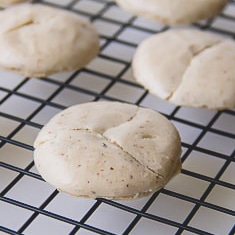
How to prevent no feet macarons:
- When the batter is too wet, macarons don’t develop those ruffled feet. The most common causes for wet batter: excess liquids, like extracts, lemon/lime juice, liquid food coloring, too much gel food coloring, etc.
- In some cases, especially in humid climates, aging egg whites might be beneficial. During aging, egg whites loose some of its moisture.
- When the meringue isn’t whipped to stiff peaks, it doesn’t have strong enough structure to lift macarons. Watch my French Meringue 101 video for visual cues for proper meringue.
- When macaron batter is over-mixed, there’s not much air bubbles left to give the shells lift during baking. Therefore, they come out flat without feet.
- Also, if macarons weren’t rested to form a skin before baking, it could cause no feet macarons. And if the shells were rested for too long, it can also negatively affect the batter, because meringue loses its stability when sat for too long. Keep checking the shells every 15 minutes and put them in the oven as soon as they don’t stick to your fingers.
- If the oven is not hot enough, macarons won’t rise as air bubbles in the meringue need heat to expand to lift the shells, creating that pretty feet at the base.
Tip
Make sure to get an oven thermometer to double check the temperature inside the oven without relying on what oven says.
Bulging feet
Potential causes:
- Too high oven temperature
- Silicone mat
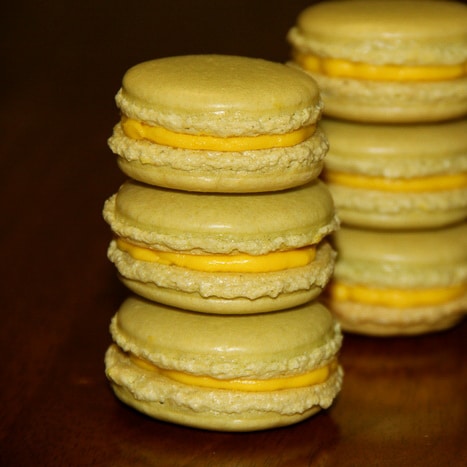
how to prevent bulging feet:
Some may find it ugly when the ruffled feet extends out of the macaron shells. I’m not a huge fan, but it’s not the worst!
- This happens when the oven is a bit too hot, causing the macarons to rise too high and then collapse slightly, making the feet bulge out.
- And another reason is silicone mat might be the culprit. I certainly happens to me with thick silicone mats, but I know some people have gorgeous macarons with silicone mats.
Soft, wrinkly shells
Possible causes:
- Too much liquid (moisture) in the batter
- Meringue is under-beaten
- Oily almond flour
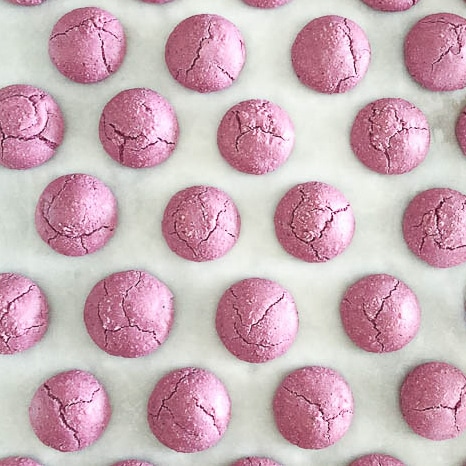
How to prevent soft, wrinkly shells:
Excess moisture and/or fat is the #1 cause for soft, wrinkly shells. And there’re number of culprits for excess moisture/fat in the batter:
- Adding liquid extracts, juices or liquid food coloring
- Adding cocoa powder, freeze-dried fruits, etc.
- Under-mixed meringue also contains too much moisture
- Oily almond flour, or almond flour that has been opened for too long
Cocoa powder contains fat which could potentially cause soft, brownie-like macaron shells. And freeze-dried fruits absorb moisture from the air fast and could cause soft, wrinkly shells as well.
Tip
Store opened almond flour in an airtight container in a cool place.
Too Thick batter
Typically, when you add dry ingredients into meringue, it starts out pretty thick and that’s totally normal. As you fold the batter, it thins out and gets runnier.
In rare occasions, the batter never loosens and it stays thick.
Possible causes:
- Improper ratio of dry and wet ingredients
- Oily almond flour
- Too much cocoa powder or freeze-dried fruits
- Overbeaten meringue
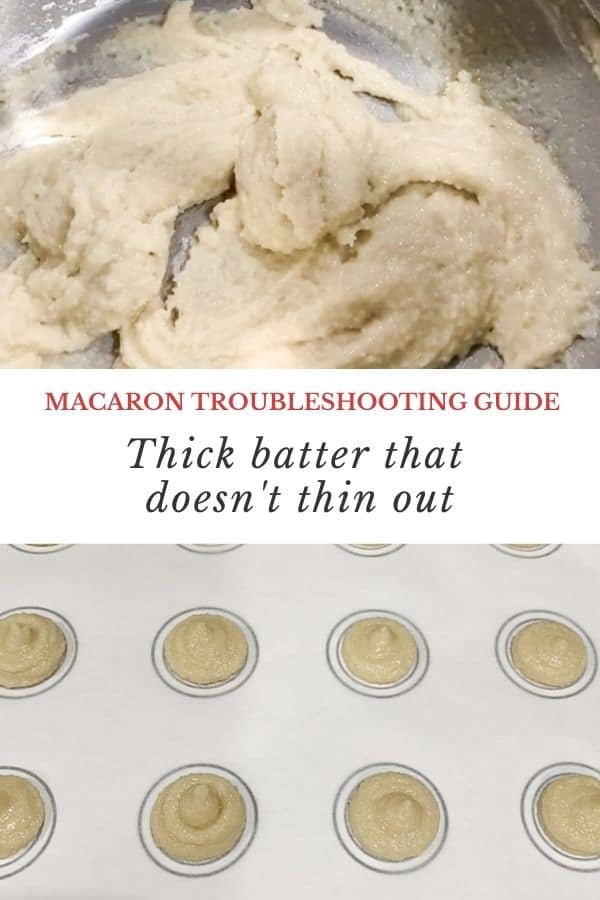
how to fix and prevent thick batter issue:
- Be sure to weigh the ingredients carefully. I strongly recommend weighing all the ingredients, including egg whites, with a kitchen scale.
- Oily almond flour could cause thick batter. Make sure to use fresh almond flour and avoid processing it in a food processor.
- Too much cocoa powder or freeze-dried fruits can throw the ratio of dry and wet ingredients.
- When meringue is over-beaten, it gets dry, throwing off the ratio as well.
Blotchy shells
I don’t have a photo of this issue, but basically it looks like greasy stains on the shells.
Possible causes:
- Oily almond flour
- Batter sat out for too long before piping
how to prevent blotchy macarons:
- Use fresh almond flour that’s not oily. To test, squeeze some almond flour in your hand and see if it holds its shape. If it holds its shape like wet sand, then it’s too oily.
- Make sure to pipe the shells right away, especially with French meringue batter.
Lopsided shells
Possible causes:
- Uneven air circulation in the oven/ Hot spots
- Convection setting (fan forced) may have too strong fan
- Improper piping technique
- Shells were dried for too long
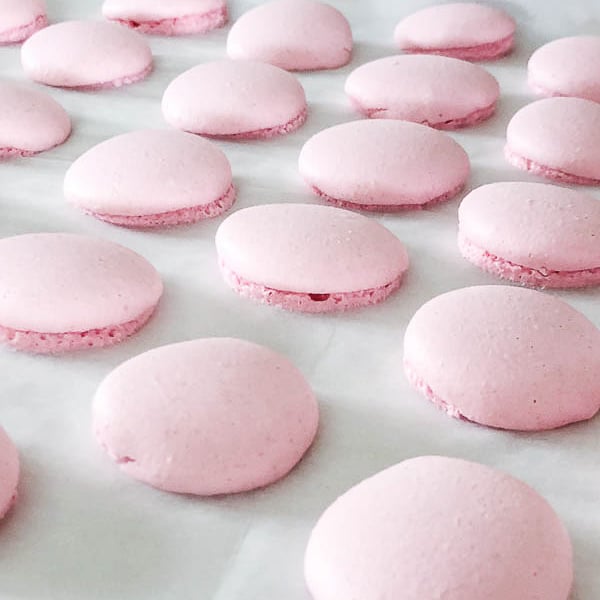
how to prevent lopsided macarons:
Main culprit for lopsided shells is poor air circulation. This could be due to uneven heat distribution and hot spots in the oven, convection settings with too strong fan. Here’re a few things you can do in this case:
- Flip the baking sheet upside down before piping macarons, so that there’s no edges around the sheet to block any heat circulation.
- Bake macarons one sheet at a time.
- Turn the baking sheet around half way through baking.
- If possible, bake on conventional setting, heat coming from top and bottom.
The next reason for lopsided macarons is improper piping technique. Pay close attention to following:
- Hold the piping bag with macaron batter straight at 90° and squeeze the batter from the top to one spot until the desired size reaches. Watch my macaron video for better illustration.
- Pipe the shells at least half an inch apart to give the shells enough room for air circulation.
And lastly, don’t dry your macarons for too long. Too thick skin may cause lopsided macarons.
Concaved (Inverted) shells or Stuck To Parchment
Possible causes:
- Low oven temp/ low heat from bottom
- Under-baked shells
- Not cooling the macarons before removing from parchment paper
How to prevent concaved, or stuck macarons:
- Make sure your oven is hot enough. Most of the time, ovens need good 30-45 minutes to preheat properly. Even if it beeps when it’s preheated, I highly recommend double checking with an oven thermometer.
- Be sure to check the macarons for doneness before taking them out. To test for doneness, gently touch the top of one macaron with your index finger and try wiggle it. If it wobbles side to side, they’re not ready. keep baking for another minute or so. The cooked shells should wiggle ever so slightly and firm to touch. When in doubt, cook a bit longer. In my opinion, it’s better to over-bake them than under-bake them.
- Make sure to cool the macarons on the baking sheet for at least 10 minutes before removing from parchment paper/silicone mat.

Whew, are you still with me? Thank you!!! I hope this macaron troubleshooting guide answers your questions and helps you to perfect your macaron skills.
And if there is anything I haven’t covered, please leave me a comment below. I’d like us, macaron-lovers, connect and discuss various problems we face baking macarons. Let’s get the discussion started.
More Favorites from Sweet & Savory
This post was originally published on December 21st, 2015, and last updated on February 16th, 2021.



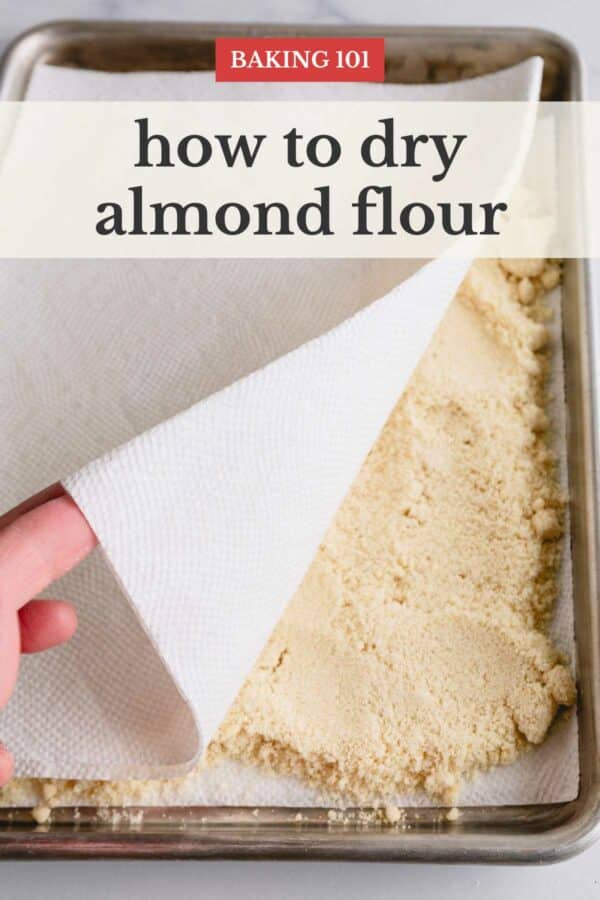


I have followed your recipe for raspberry & white chocolate macarons everything was followed to the letter including freshly ground dried raspberries. The batter piped beautifully & a good skin developed ( although may have left for too long 45 minutes ?) Macarons developed feet & rose & came off tray mostly easily & cleanly but they all had cracked tops fan oven was on 130•c & also tried lowering to 125•c but macarons were still sticking to the sheet whilst longer baking discoloured them I have tried about 10 attempts but no perfect success yet , waiting for that euphoric moment but beginning to lose hope now 😞
Hi! Last night I baked 40 macarons (in 4 different colors and flavors)
The results were insane…!
Only 2 batches came out perfectly, smooth and weren’t ruffled.
But 1 out of those 2 batches was as hard as rock so we couldn’t eat it, although it’s filling was so moist 🙁 what’s wrong with my macs 🥲
Hi, Nil. Sorry to answer your questions with more questions. Were they all the same recipe? All had the same filling? How long have you matured them? The answer would lie in some of these answers.
Hello, my macaron shells won’t form the skin. I’m on my second batch. The first batch set for 2 hours before they weren’t tacky anymore. Then when I baked them, they didn’t form feet. The only thing I can think of is I used a different brand almond flour (blue diamond). Could this be the reason?
Hi, Alisa. I doubt it’s because of the almond flour, but then again it could be. The main reason macarons don’t form a film is due to high humidity. Do you think it was more humid the day you baked the macarons?
Hi Alisa, same thing happened to me and I noticed I added to much gel color And I did over sift the flour. The best flour to use is blue diamond. Because you don’t have to sift as much and it helps because the more you sift the oilier it will get. Leaving you with extra moisture. Which is the problem. If you’re in a humid weather try leaving a fan close to help with the drying.(in front of them) They will develop the shell faster and properly. Check them every 15 min and bake as soon as they feel dry to the touch.
Hi! So I’ve recently ran into an issue I have ran into with macarons before (i haven’t been making them that long): the tops cave in or dimple when I remove them from the oven.
When I remove them from the oven (convention 300F for 19 min) the feet are slightly browned on the bottom. They still dimple. The inside looks set though. And if I keep them in longer they just get hard (but do not dimple if rock hard) and very browned. This happens with or without gel food coloring. Sometimes there are some on the tray that do not dimple. Sometimes they look blotchy and dimpled and sometimes they don’t look blotchy but always dimples. I think my egg whites are pretty stiff peaks. I also think the batter is thin enough when I pipe it. I don’t think I’m over mixing the batter. I clean my equipment with vinegar. I’ve tried aging my egg whites over night.. I let them get to room temp. I fry the piped shells about an hour… bang the trays to get air bubbles out.. poke out remaining bubbles. Oven preheats for 30 min before baking.
I just don’t know what to do. I’m going to try a new almond flour brand. I just don’t know where the extra moisture is coming from or how to fix it or if extra moisture is even the issue.
Do you have any suggestions on what my issue is or what I can try??
Hi, Emily! Thanks for reaching out and providing all the details. It’s so helpful! And I’m pretty sure your almond flour is the main culprit. Specifically, the issue may be due to oily almond flour. I highly recommend trying a different brand of almond flour and use freshly opened package. Please let me know how they turn out with a new almond flour.
Thank you for your reply! I did buy some Almond flour today & I will keep you posted.
Hi Tanya
I use the Italian method, followed the recipe as far as I know correctly. My macaronage is at ribbon stage, they pipe okay (shell shape) but they start to spread and loose all the shells definition while resting. I don’t know what I’m doing wrong.
I am so happy I found you! I made my first macaron this weekend. Well, after two failed attempts, I made YOUR macaron! Overall a success except that the shells aren’t very crisp. They’re not soggy or overly squishy, I just wish the shells were a bit more crisp.
Should I rest for longer, bake longer or both?
Also- with my kitchen aid mixer on #2 how long should it take for the merengue? I was watching it for 40 minutes until I gave up and slowly increased to 8. Love to know how long it should take.
Hi, Tanya! Resting longer won’t make difference. I recommend baking it 30-60 seconds longer. At speed 2, it usually take 40-45 minutes for me. I did notice, each KitchenAid mixer is different though. It seems like my older one has faster engine than the newer one. On my new on, it takes longer. So I usually mix my meringue on speed 4 on my new one.
What brand of almond flour do you use? I’m sifting 3 times as you recommend but my batter still looks a bit grainy.
I use Bob’s Red Mill super fine almond flour. Note: this brand carries 2 different almond flours. Make sure to choose “super fine” one.
Your video times do not match the printed times in the recipe. Is it 300 degrees for 18-20 minutes as stated in the video or less time as listed in the typed version?
Hi, Susan. I apologize for confusion. My initial recipe was written in my old kitchen/oven, where my macarons took 15-18 minutes to bake. In my new house/oven, where I filmed my video, it takes 18-20 minutes. Yes, even though both ovens are at 300°F. So, I recommend start checking at 15 minutes, but most likely it’ll take 18 minutes.
That makes sense. Thank you!
How do you fix thick batter? Can you add water or more egg white? Thanks
Hi, Natasha! Thick batter issue is best when it’s prevented rather than fixing it, because it’s nearly impossible to fix it perfectly. You could try adding little bit of whipped egg whites, but it may not work. Definitely don’t add water!
Hi.
Thank you very much for this important tutorial.
I’ve been trying baking macaroons recently, but i haven’t figured out what is wrong.
I have oven thermometer, i tried with convection and with out it, followed the instructions for macronage, and keep failing.
I don’t know what is wrong, so I can’t improve…
Hi, Rev. You haven’t mentioned what kind of issues you’re running into? If you’d like me to help with troubleshooting your macaron troubles, please provide detailed description of the issues.